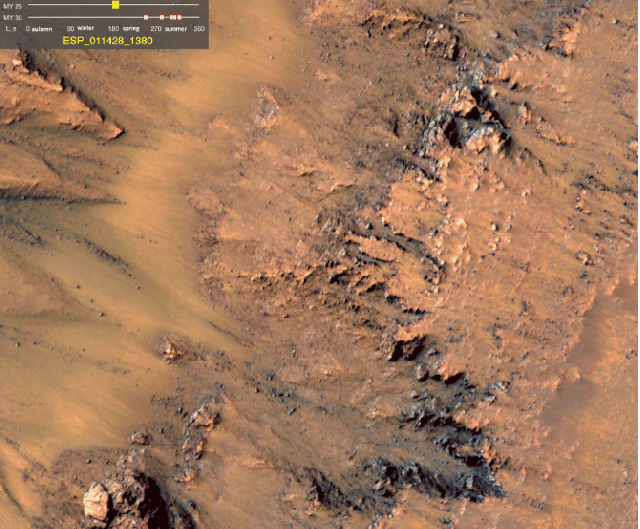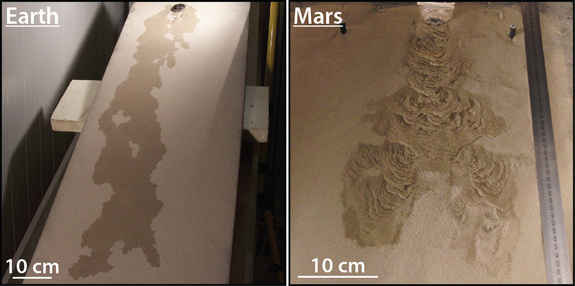Last year, we all got really excited when scientists announced the most compelling evidence so far that salty, liquid water flows on Mars. Now researchers have revealed that something even more incredible is likely happening on the Red Planet - that flowing water is also boiling.
It sounds crazy, but the hypothesis solves a lot of unanswered questions that were lingering after the initial discovery, and also explains those mysterious, darks streaks we see growing and fading on the surface of the planet each year.
The initial evidence of liquid water came from the discovery of hydrated salt minerals inside these streaks, which run down the slopes of Mars each summer (which is still really cold by Earth's standards), lengthen as the planet heats up, and then fade as they cool.
These lines are so big that we can see those seasonal changes in them from our own satellites and telescopes:
 NASA
NASA
What's been confusing for scientists is how liquid water is able to survive on Mars's surface long enough to etch out these lines. Because, given our understanding of water here on Earth, it should either boil or freeze in the low pressure of the Red Planet's atmosphere.
"The atmospheric pressure on Mars is very low compared to that on the Earth, which means that water boils at a much lower temperature than it does on Earth," one of the researchers, Susan Conway from the University of Nantes in France, told Ria Misra at Gizmodo. "On the Martian surface the pressure is 5 to 10 millibars, meaning that liquid water boils no matter what the temperature is."
That makes sense, but then if the water isn't liquid, what's creating the streaks? To figure this out, the scientists pain-stakingly recreated the conditions on Mars' surface in the lab, and then put a block of ice on a sand-covered slope and watched what happened as it melted.
They found that, under the simulated Martian conditions, the melting ice produced a liquid that started boiling vigorously, blasting up grains of sand and forming deep channels as it flowed down the slope and filtered into the sand.
In the same experiment under Earth conditions, the melting water didn't make much of an impact at all, showing how the flowing water on Mars can etch out those dark streaks:
 Massé et al., Nature
Massé et al., Nature
With the new understanding of how water behaves on the Red Planet, it makes sense that even small amounts of flowing water can make such a big impact on the surface of the planet.
And here's how that looks in action. What's cool is that the sand actually pops as the salty brine runs down it:


This new finding is pretty awesome for our understanding of Mars, but it's also bad news for the prospect of discovering life on the Red Planet. While this evidence backs up the idea that there's liquid water on the planet, it also suggests that there's a lot less water than we originally thought.
"[Our results] show much less water is needed and that the water that is produced is very short-lived - therefore not a fabulous environment for micro-organisms," Conway told Gizmodo.
Of course, just because we now know how salty brine flows under Mars-like conditions in the lab, doesn't mean we know how it flows on the Red Planet. One criticism is the fact that these experiments can't mimic Martian gravity.
But the researchers' calculations suggest that, "the boiling effects might be even more intense under Martian gravity", Conway told Space.com.
"[However], indisputable proof that this process indeed happens on the surface of Mars could only be obtained through observations or experiments performed by future explorers, or possibly rovers," she added.
As we learn previously, the rovers we have on Mars right now are too unhygienic to go check out the water themselves, so it's even more reason for us to hurry up and get over to the Red Planet to study the liquid ourselves.
In the meantime, Conway and her co-researchers are going to continue studying the Martian water in the lab, and plan to test how its flow changes with variations in temperature and sediment type. "Our preliminary work suggests even more weird effects happen at higher water-flow rates," says Conway.
The research has been published in Nature Geoscience.
